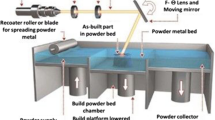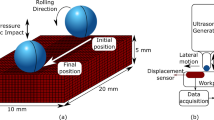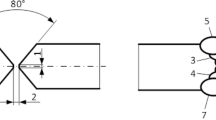Abstract
In this paper, a theoretical framework was developed to incorporate BBC 2008 advanced yield criterion into the classical Marciniak–Kuczynski theory to compute limit strains of anisotropic metallic sheets. The classical Hill’s 48 yield function was also utilized to compare with the results obtained by BBC 2008. The anisotropy parameters contained in BBC 2008 yield function were identified by minimizing an error function using Levenberg–Marquardt method. The data from uniaxial and plane strain tensile testings were employed to establish the error function. All the experimental tests were performed on AA 3003-H19 aluminum sheets. The yield criteria were assessed from the standpoint of predicting material properties and the yield locus by comparing theoretical findings and experimental data. The influence of the use and non-use of the plane strain yield stresses in the identification procedure on the FLD calculation was also investigated. To verify the theoretical predictions of the FLD, a series of Nakajima tests were accomplished. Comparing the experimental results and theoretical predictions revealed that the best agreement was found when BBC 2008-16p yield function was utilized to express the yield locus. Failure to use the plane strain yield stresses in the calibration procedure of the BBC 2008-16p criterion also causes overpredicting the limit strains for positive strain ratios.
















Similar content being viewed by others
Abbreviations
- \(C\) :
-
Constant
- \({f}_{0}\), f :
-
Initial and current imperfection factor
- \({f}^{\mathrm{ps}}\) :
-
Slope of total force–width diagram for plane strain tensile test
- \({F}_{nn}\) :
-
Normal force applied to the interface of perfect and imperfect regions
- \({F}_{nt}\) :
-
Shear force applied to the interface of perfect and imperfect regions
- \({F}_{t}\) :
-
Total force measured experimentally
- \({F}_{e}\) :
-
Force applied to the notch-affected zone
- F, G, H, L, M, N :
-
Anisotropy parameters of Hill’s 48 yield criterion
- \(g\left(\alpha \right)\) :
-
Strain ratio in terms of stress ratio
- \(h\left(\alpha \right)\) :
-
Effective stress in terms of stress ratio
- K :
-
Strain hardening coefficient
- \({l}_{i}, {m}_{i}, {n}_{i},k,s\) :
-
Anisotropy parameters in BBC2008 yield criterion
- n :
-
Strain hardening exponent
- \(\left[Q\right]\) :
-
Rotation matrix
- \({r}_{b}\) :
-
Equi-biaxial r value for a specimen oriented along RD and TD
- \({r}_{{\varphi }_{i}}\) :
-
Lankford coefficient (r value) along \({\varphi }_{i}\) angle with respect to the rolling direction
- RD, TD, ND:
-
Rolling direction, transverse direction, normal direction
- \({t}_{0},t\) :
-
Initial and current thickness of sheet metal
- \(W\) :
-
Total width of specimens
- \({W}^{ps}\) :
-
Width of plane strain region
- \({W}^{e}\) :
-
Width of the notch-affected zone
- \({Y}_{{\varphi }_{i}}\) :
-
Uniaxial yield stress along \({\varphi }_{i}\) angle with respect to the rolling direction
- \({Y}_{b}\) :
-
Equi-biaxial yield stress for a specimen oriented along RD and TD
- \({{Y}_{{\psi }_{i}}}^{ps}\) :
-
Plane strain yield stress along \({\psi }_{i}\) angle with respect to the rolling direction
- \({\sigma }_{ji}\) (i, j = 1, 2, 3):
-
Stress components in the plastic orthotropy axes
- \({{\sigma }_{nn}}^{B}\), \({{\sigma }_{tt}}^{B}\) :
-
Normal stress components along normal and transverse directions of the groove
- \({{\sigma }_{nt}}^{B}\),:
-
Shear stress component along the transverse direction of the groove
- \({\sigma }^{\mathrm{ps}}\) :
-
Plane strain yield stress
- \({\varepsilon }_{ji}\) (i, j = 1,2,3):
-
Strain components in the plastic orthotropy axes
- \(\rho\) :
-
Strain ratio in the perfect region
- \(\alpha\) :
-
Stress ratio in the perfect region
- \(\theta\) :
-
Groove orientation angle
- \(\Delta r\) :
-
Comparative or relative deviations of r values
- \(\Delta \sigma\) :
-
Comparative or relative deviations of yield stresses
- \({\left(\right)}^{A}\) :
-
Parameters and variables related to the perfect region
- \({\left(\right)}^{B}\) :
-
Parameters and variables related to the groove region
References
Keeler SP (1961) Plastic instability and fracture in sheets stretched over rigid punches. Massachusetts Institute of Technology
Goodwin GM (1968) Application of strain analysis to sheet metal forming problems in the press shop. SAE Trans 77:380–387
Swift HW (1952) Plastic instability under plane stress. J Mech Phys Solids 1:1–18
Hill R (1952) On discontinuous plastic states, with special reference to localized necking in thin sheets. J Mech Phys Solids 1:19–30
Marciniak Z, Kuczyński K (1967) Limit strains in the processes of stretch-forming sheet metal. Int J Mech Sci 9:609–620
Hutchinson J, Neale K (1978) Sheet necking-II. Time-independent behavior. Mechanics of sheet metal forming. Springer, pp 127–153
Hutchinson J, Neale K (1978) Sheet necking-III. Strain-rate effects. Mechanics of sheet metal forming. Springer, pp 269–285
Stören S, Rice J (1975) Localized necking in thin sheets. J Mech Phys Solids 23:421–441
Hora P, Tong L (2006) Numerical prediction of FLC using the enhanced modified maximum force criterion (eMMFC). Numerical and experimental methods in prediction of forming limits in sheet forming and tube hydroforming processes, pp 31–36
Hora P, Tong L, Reissner J (2003) Mathematical prediction of FLC using macroscopic instability criteria combined with micro structural crack propagation models. Plasticity, Quebec, Canada, pp 364–366
Banabic D, Paraianu L, Dragos G, Bichis I, Comsa DS (2009) An improved version of the modified maximum force criterion (MMFC) used for predicting the localized necking in sheet metals. Proc Rom Acad Series A-Math Phys Tech Sci Inf Sci 10
Paraianu L, Dragos G, Bichis I, Comsa DS, Banabic D (2010) A new formulation of the modified maximum force criterion (MMFC). IntJ Mater Form 3:243–246
Manopulo N, Hora P, Peters P, Gorji M, Barlat F (2015) An extended Modified Maximum Force Criterion for the prediction of localized necking under non-proportional loading. Int J Plast 75:189–203
Tvergaard V (1982) On localization in ductile materials containing spherical voids. Int J Fract 18:237–252
Tvergaard V, Needleman A (1984) Analysis of the cup-cone fracture in a round tensile bar. Acta Metall 32:157–169
Xue L (2007) Damage accumulation and fracture initiation in uncracked ductile solids subject to triaxial loading. Int J Solids Struct 44:5163–5181
Bao Y, Wierzbicki T (2004) On fracture locus in the equivalent strain and stress triaxiality space. Int J Mech Sci 46:81–98
Mohr D, Marcadet SJ (2015) Micromechanically-motivated phenomenological Hosford–Coulomb model for predicting ductile fracture initiation at low stress triaxialities. Int J Solids Struct 67:40–55
Lou Y, Chen L, Clausmeyer T, Tekkaya AE, Yoon JW (2017) Modeling of ductile fracture from shear to balanced biaxial tension for sheet metals. Int J Solids Struct 112:169–184
Lian J, Zhou D, Baudelet B (1989) Application of Hill’s new yield theory to sheet metal forming—Part I. Hill’s 1979 criterion and its application to predicting sheet forming limit. Int J Mech Sci 31:237–247
Lian J, Barlat F, Baudelet B (1989) Plastic behaviour and stretchability of sheet metals. Part II: Effect of yield surface shape on sheet forming limit. Int J Plast 5:131–147
Xu S, Weinmann KJ (1998) Prediction of forming limit curves of sheet metals using Hill’s 1993 user-friendly yield criterion of anisotropic materials. Int J Mech Sci 40:913–925
Cao J, Yao H, Karafillis A, Boyce MC (2000) Prediction of localized thinning in sheet metal using a general anisotropic yield criterion. Int J Plast 16:1105–1129
Banabic D, Dannenmann E (2001) Prediction of the influence of yield locus on the limit strains in sheet metals. J Mater Process Technol 109:9–12
Butuc M, Da Rocha AB, Gracio J, Duarte JF (2002) A more general model for forming limit diagrams prediction. J Mater Process Technol 125:213–218
Butuc M, Banabic D, da Rocha AB, Gracio J, Duarte JF, Jurco P et al (2002) The performance of Yld96 and BBC2000 yield functions in forming limit prediction. J Mater Process Technol 125:281–286
Ávila AF, Vieira EL (2003) Proposing a better forming limit diagram prediction: a comparative study. J Mater Process Technol 141:101–108
Dariani B, Azodi H (2003) Finding the optimum Hill index in the determination of the forming limit diagram. Proc Inst Mech Eng Part B J Eng Manuf 217:1677–1683
Banabic D, Comsa S, Jurco P, Cosovici G, Paraianu L, Julean D (2004) FLD theoretical model using a new anisotropic yield criterion. J Mater Process Technol 157:23–27
Ganjiani M, Assempour A (2007) An improved analytical approach for determination of forming limit diagrams considering the effects of yield functions. J Mater Process Technol 182:598–607
Ahmadi S, Eivani A, Akbarzadeh A (2009) An experimental and theoretical study on the prediction of forming limit diagrams using new BBC yield criteria and M–K analysis. Comput Mater Sci 44:1272–1280
Dasappa P, Inal K, Mishra R (2012) The effects of anisotropic yield functions and their material parameters on prediction of forming limit diagrams. Int J Solids Struct 49:3528–3550
Panich S, Barlat F, Uthaisangsuk V, Suranuntchai S, Jirathearanat S (2013) Experimental and theoretical formability analysis using strain and stress based forming limit diagram for advanced high strength steels. Mater Des 51:756–766
Basak S, Panda SK (2019) Failure strains of anisotropic thin sheet metals: experimental evaluation and theoretical prediction. Int J Mech Sci 151:356–374
Djavanroodi F, Ebrahimi M, Janbakhsh M (2019) A study on the stretching potential, anisotropy behavior and mechanical properties of AA7075 and Ti–6Al–4V alloys using forming limit diagram: an experimental, numerical and theoretical approaches. Results Phys 14:102496
Lei C, Mao J, Zhang X, Liu J, Wang L, Chen D (2021) A comparison study of the yield surface exponent of the Barlat yield function on the forming limit curve prediction of zirconium alloys with MK method. Int J Mater Form 14:467–484
Aghchai AJ, Shakeri M, Mollaei-Dariani B (2008) Theoretical and experimental formability study of two-layer metallic sheet (Al1100/St12). Proc Inst Mech Eng Part B J Eng Manuf 222:1131–1138
Aghchai AJ, Shakeri M, Dariani BM (2013) Influences of material properties of components on formability of two-layer metallic sheets. Int J Adv Manuf Technol 66:809–823
Hill R (1948) A theory of the yielding and plastic flow of anisotropic metals. Proc R Soc Lond A 193:281–297
Hill R (1979) Theoretical plasticity of textured aggregates. Mathematical Proceedings of the Cambridge Philosophical Society. Cambridge University Press, pp 179–191
Hill R (1990) Constitutive modelling of orthotropic plasticity in sheet metals. J Mech Phys Solids 38:405–417
Hill R (1993) A user-friendly theory of orthotropic plasticity in sheet metals. Int J Mech Sci 35:19–25
Banabic D (2010) Sheet metal forming processes: constitutive modelling and numerical simulation. Springer
Banabic D, Aretz H, Comsa D, Paraianu L (2005) An improved analytical description of orthotropy in metallic sheets. Int J Plast 21:493–512
Banabic D, Kuwabara T, Balan T, Comsa D (2004) An anisotropic yield criterion for sheet metals. J Mater Process Technol 157:462–465
Banabic D, Kuwabara T, Balan T, Comsa D, Julean D (2003) Non-quadratic yield criterion for orthotropic sheet metals under plane-stress conditions. Int J Mech Sci 45:797–811
Comsa D-S, Banabic D (2008) Plane stress yield criterion for highly anisotropicsheet metals. Numisheet 2008, Interlaken, Switzerland, pp 43–48
Barlat F, Brem J, Yoon JW, Chung K, Dick R, Lege D et al (2003) Plane stress yield function for aluminum alloy sheets—part 1: theory. Int J Plast 19:1297–1319
Barlat F, Aretz H, Yoon JW, Karabin M, Brem J, Dick R (2005) Linear transfomation-based anisotropic yield functions. Int J Plast 21:1009–1039
Aretz H, Barlat F (2013) New convex yield functions for orthotropic metal plasticity. Int J Non-Linear Mech 51:97–111
Yoon JW, Lou Y, Yoon J, Glazoff MV (2014) Asymmetric yield function based on the stress invariants for pressure sensitive metals. Int J Plast 56:184–202
Lou Y, Yoon JW (2018) Anisotropic yield function based on stress invariants for BCC and FCC metals and its extension to ductile fracture criterion. Int J Plast 101:125–155
Cazacu O (2020) New expressions and calibration strategies for Karafillis and Boyce (1993) yield criterion. Int J Solids Struct 185:410–422
Cazacu O (2019) New mathematical results and explicit expressions in terms of the stress components of Barlat et al. (1991) orthotropic yield criterion. Int J Solids Struct 176:86–95
Vrh M, Halilovič M, Starman B, Štok B, Comsa D-S, Banabic D (2014) Capability of the BBC2008 yield criterion in predicting the earing profile in cup deep drawing simulations. Eur J Mech A/Solids 45:59–74
Alizad-Kamran M, Gollo MH, Hashemi A, Seyedkashi SH (2018) Determination of critical pressure in analyzing of rupture instability for hydromechanical deep drawing using advanced yield criterion. Arch Civ Mech Eng 18:103–113
Aretz H, Hopperstad OS, Lademo O-G (2007) Yield function calibration for orthotropic sheet metals based on uniaxial and plane strain tensile tests. J Mater Process Technol 186:221–235
Levenberg K (1944) A method for the solution of certain non-linear problems in least squares. Q Appl Math 2:164–168
An Y, Vegter H, Elliott L (2004) A novel and simple method for the measurement of plane strain work hardening. J Mater Process Technol 155:1616–1622
Weixian Z (1990) A new non-quadratic orthotropic yield criterion. Int J Mech Sci 32:513–520
Leacock AG (2006) A mathematical description of orthotropy in sheet metals. J Mech Phys Solids 54:425–444
Butuc M, Gracio J, Da Rocha AB (2003) A theoretical study on forming limit diagrams prediction. J Mater Process Technol 142:714–724
Zhang F, Chen J, Chen J, Zhu X (2014) Forming limit model evaluation for anisotropic sheet metals under through-thickness normal stress. Int J Mech Sci 89:40–46
Funding
No funding was received to assist with the preparation of this manuscript.
Author information
Authors and Affiliations
Corresponding author
Ethics declarations
Conflict of interest
The authors have no competing interests to declare that are relevant to the content of this article.
Ethical approval
This article does not contain any studies with human participants or animals performed by any of the authors.
Additional information
Technical Editor: João Marciano Laredo dos Reis.
Publisher's Note
Springer Nature remains neutral with regard to jurisdictional claims in published maps and institutional affiliations.
Appendix A
Appendix A
A more detailed description of each term of Eq. (8) is presented as follows:
Rights and permissions
Springer Nature or its licensor holds exclusive rights to this article under a publishing agreement with the author(s) or other rightsholder(s); author self-archiving of the accepted manuscript version of this article is solely governed by the terms of such publishing agreement and applicable law.
About this article
Cite this article
Alizad Kamran, M., Mollaei Dariani, B. Accuracy improvement of FLD prediction for anisotropic sheet metals using BBC 2008 advanced yield criterion. J Braz. Soc. Mech. Sci. Eng. 44, 478 (2022). https://doi.org/10.1007/s40430-022-03770-x
Received:
Accepted:
Published:
DOI: https://doi.org/10.1007/s40430-022-03770-x




